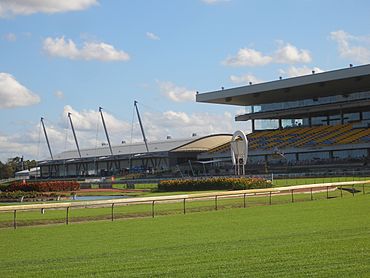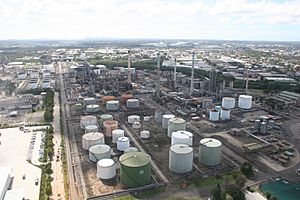Rosehill, New South Wales facts for kids
Quick facts for kids RosehillSydney, New South Wales |
|||||||||||||||
|---|---|---|---|---|---|---|---|---|---|---|---|---|---|---|---|

Rosehill Racecourse
|
|||||||||||||||
| Population | 3,806 (2016 census) | ||||||||||||||
| • Density | 1,029/km2 (2,670/sq mi) | ||||||||||||||
| Postcode(s) | 2142 | ||||||||||||||
| Elevation | 8 m (26 ft) | ||||||||||||||
| Area | 3.7 km2 (1.4 sq mi) | ||||||||||||||
| Location | 18 km (11 mi) west of Sydney CBD | ||||||||||||||
| LGA(s) | City of Parramatta | ||||||||||||||
| Federal Division(s) | Parramatta | ||||||||||||||
|
|||||||||||||||
Rosehill is a suburb located in Sydney, New South Wales, Australia. It sits about 18 kilometres west of the main city centre of Sydney. Rosehill is part of the City of Parramatta area and is found in the Greater Western Sydney region.
This suburb shares its postcode, 2142, with other nearby areas. These include Granville, South Granville, Holroyd, and Camellia. Rosehill has a mix of homes, businesses, industrial areas, and places for fun activities.
Contents
What is the History of Rosehill?
The area now known as Rosehill has a long history. Early in Australia's colonial days, Governor Arthur Phillip named a hill behind the old Government House 'Rose Hill'. This was even before the nearby suburb of Parramatta got its name.
In March 1789, a farm was started at Rose Hill, managed by Henry Dodd. Later that year, James Ruse began farming there too. By December 1790, a "very good" crop of wheat was harvested. By 1791, about 200 acres of land were cleared and being used for farming.
Almost a hundred years later, in 1883, a large part of John Macarthur's Elizabeth Farm was divided up. This land was used for industrial purposes. A section of the estate was set aside for a recreation area. This area later became the famous Rosehill Racecourse.
A public school opened in Rosehill in 1886. The railway station followed in 1888. This station was on the Carlingford railway line. The railway line was first privately owned, then taken over by the government in 1904. It closed in January 2020.
What are the Important Places in Rosehill?
Rosehill is home to several important and interesting places.
Famous Racecourse
The Rosehill Gardens Racecourse is one of the most well-known spots. It hosts major horse racing events in Australia. One of the biggest races held here is the prestigious Golden Slipper.
Historic Elizabeth Farm
You can also visit the historic Elizabeth Farm. This was the home of John Macarthur, who was a pioneer in Australia's wool industry. It's a great place to learn about early colonial life.
Local Hotel
The Mercure Sydney Parramatta Hotel is another landmark. It used to be known as the Travelodge Rosehill.
What About Education in Rosehill?
Rosehill has its own local school.
- Rosehill Public School
What is the Population of Rosehill Like?
According to the 2016 census, Rosehill had a population of 3,806 people. Here are some interesting facts about the people living there:
Age Groups
The age of people in Rosehill is a bit different from the rest of Australia. There are more young adults, especially those between 20 and 34 years old. This age group makes up 43.5% of residents. The average age in Rosehill was 31 years, which is younger than the national average of 38 years. Children aged 0–14 years made up 16.9% of the population. People aged 65 years and over made up only 4.5%.
Where People Come From
Only 28.6% of people in Rosehill were born in Australia. Many people have come from other countries. The most common countries of birth after Australia were India (25.3%), China (6.6%), Lebanon (3.3%), and the Philippines (2.8%). About three-quarters (74.8%) of residents had both parents born overseas.
Languages Spoken
About 25.3% of people spoke only English at home. Many other languages are spoken in Rosehill. These include Gujarati (9.5%), Arabic (7.6%), Mandarin (7.0%), Hindi (7.0%), and Punjabi (4.9%).
Religions
The most common religions in Rosehill were Hinduism (24.0%), Catholic (18.9%), and No Religion (16.0%).
Housing and Work
About 8.4% of the people who work were unemployed. Most households (66.5%) were families, and 26.3% were single-person households. Most homes (71.4%) were flats, units, or apartments. About 62.5% of homes were rented.


